Everything that you need to know about the Inverted Hammer candlestick pattern is here.
Today you’ll learn:
- What Is The Inverted Hammer Candlestick Pattern
- How To Identify The Inverted Hammer Candlestick Pattern
- Variants of the Inverted Hammer Candlestick Pattern
- How To Trade The Inverted Hammer Candlestick Pattern
- Strategies To Trade The Inverted Hammer Candlestick Pattern
- Strategy 1: Pullbacks On Naked Charts
- Strategy 2: Trading The Inverted Hammer With Support Levels
- Strategy 3: Trading The Inverted Hammer With Moving Averages
- Strategy 4: Trading The Inverted Hammer With RSI Divergences
- Strategy 5: Trading The Inverted Hammer With Fibonacci
- Strategy 6: Trading The Inverted Hammer With Pivot Points
- What Is The Success Rate Of The Inverted Hammer?
- This is what you learned today
- Learn More
What Is The Inverted Hammer Candlestick Pattern
The Inverted Hammer is a Japanese candlestick pattern.
It’s a bullish reversal pattern.
It usually appears after a price decline and shows rejection from lower prices.
It’s a bullish pattern because we expect to have a bull move after an Inverted Hammer appears at the right location.
It’s a reversal pattern because before the Inverted Hammer appears we want to see the price going up, thus it’s also a frequent signal of the end of a trend.
The Inverted Hammer pattern is also a mirrored version of the Hammer Candlestick Pattern.
How To Identify The Inverted Hammer Candlestick Pattern
The Inverted Hammer candlestick pattern is formed by one single candle.
Here’s how to identify the Inverted Hammer candlestick pattern:
- The candle has a small body
- The wick at the top must be big compared to the body
- At the bottom, it should have no wick, or be very small
- The color of the body doesn’t matter
It looks like this on your charts:
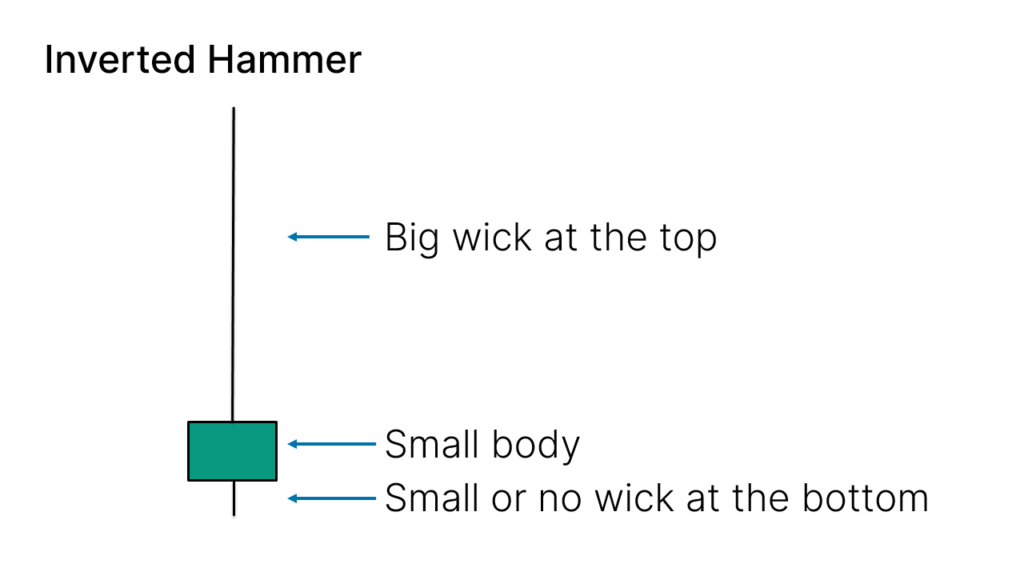
Variants of the Inverted Hammer Candlestick Pattern
The Inverted Hammer candlestick pattern may appear a little different on your charts.
The color of the body doesn’t matter, it can be either red or green (bearish or bullish).
The existence or not of a wick (shadow) at the bottom doesn’t matter too. As long as it’s small you’re good to go.
Here’s what it may look like on your charts:
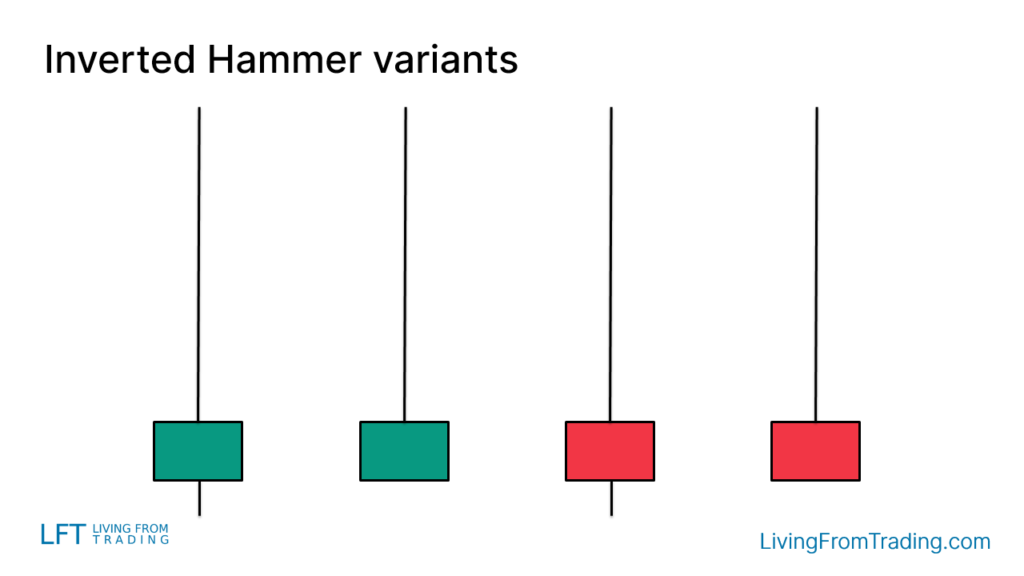
How To Trade The Inverted Hammer Candlestick Pattern
To trade the Inverted Hammer candlestick pattern it’s not enough to simply find a candle with the same shape on your charts.
In fact, there are other candlestick patterns that have the exact same shape, like the Shooting Star.
Confused?
Let me explain.
What makes a pattern valid is not just the shape, but also the location where it appears.
This means that the same shape appearing at different locations may have different meanings.
When trading the Inverted Hammer, we want to see the price first going down, making a bearish move.
An Inverted Hammer appearing after this bearish move is a sign of a possible reversal to the upside.
It looks like this:
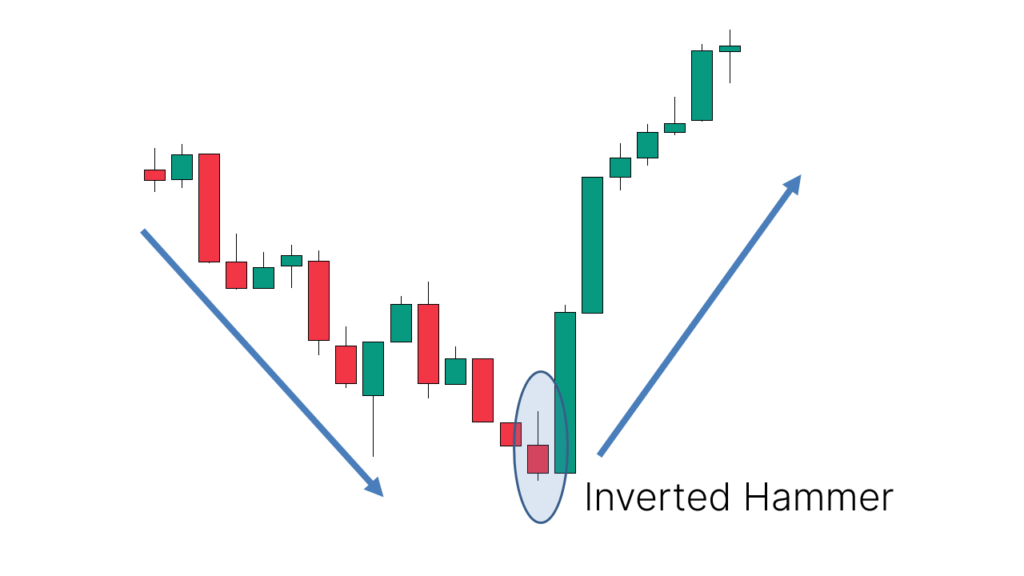
Now you’re thinking.
“When do I open my trade?”
It’s simple, the Inverted Hammer pattern is traded when the high of the candle is broken.
That’s your conservative trigger to go long.
It looks like this:
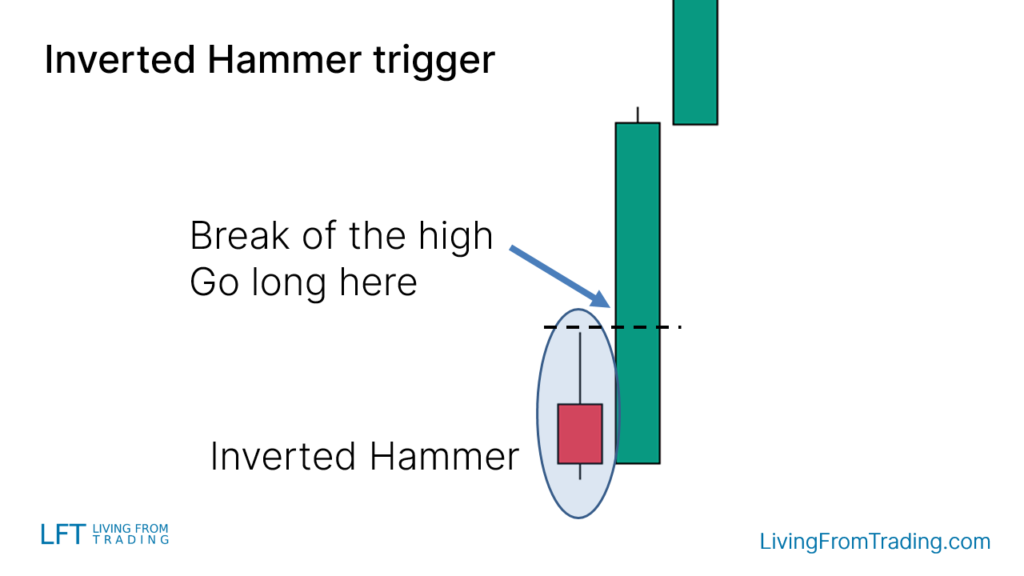
Now, you also want to protect yourself because when trading things don’t always move as we expect.
And for that, we use a stop loss.
There are several different types of stop losses.
The most common is to use the other side of the pattern to set it.
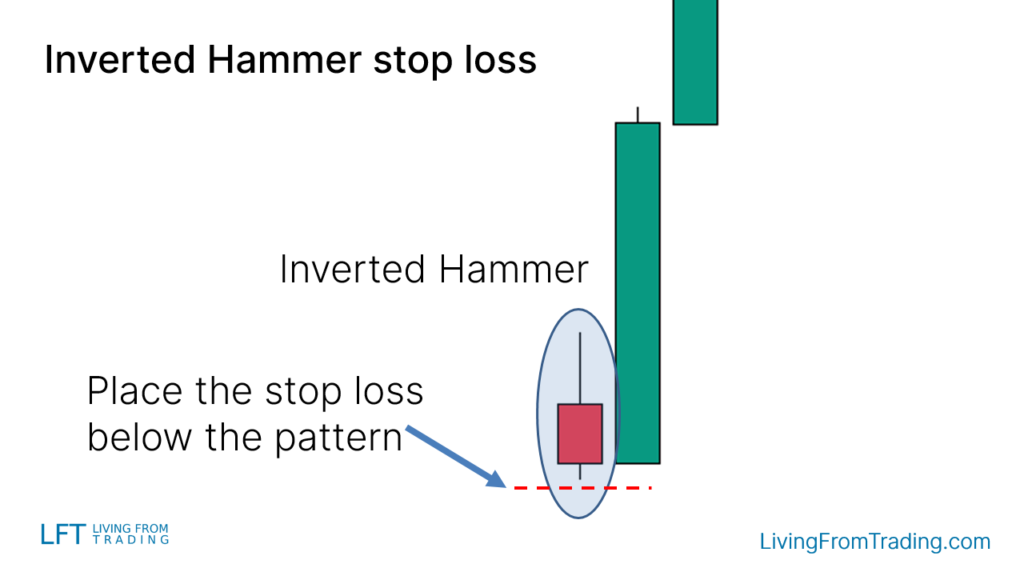
But wait, don’t jump into trading the Inverted Hammer right yet.
There are a few more things to know.
Ideally, to increase the accuracy, we want to trade the Inverted Hammer candlestick pattern by combining it with other types of technical analysis or indicators.
Here are a few strategies to trade the Inverted Hammer pattern.
Strategies To Trade The Inverted Hammer Candlestick Pattern
Strategy 1: Pullbacks On Naked Charts
As a bullish reversal pattern, the Inverted Hammer is a great pattern to watch for when the price is on an uptrend.
Just wait for a pullback to start, and then spot when the Inverted Hammer appears.
That often signs the end of the pullback and the start of the new leg to the upside.
Here’s an example:
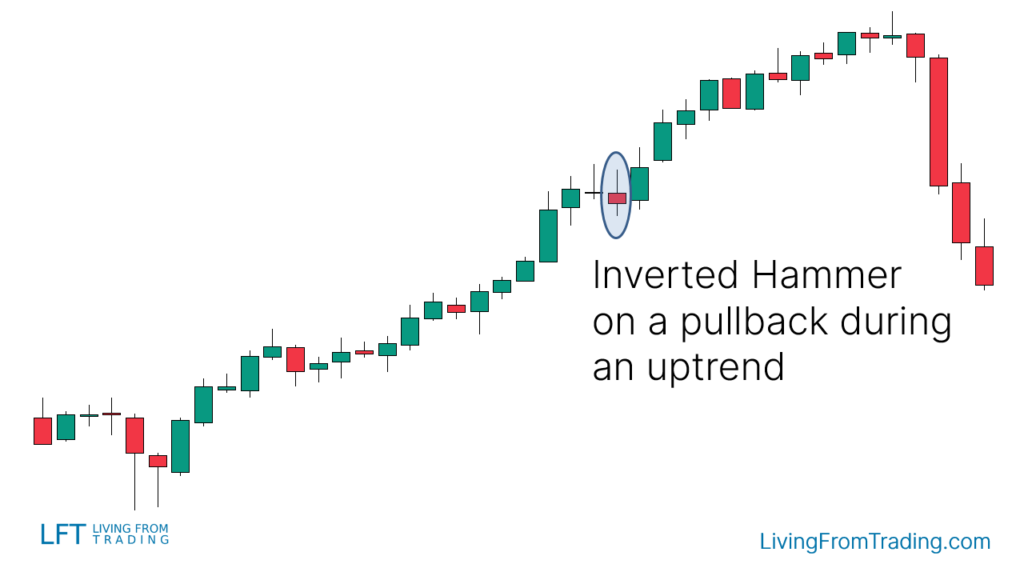
Strategy 2: Trading The Inverted Hammer With Support Levels
Support and resistance levels are great places to find price reversals.
Since we are looking for moves to the upside, we want to trade the Inverted Hammer using support levels.
How does it work:
- Draw support levels on your charts
- Wait for the price to decline and hit the support level
- Check if an Inverted Hammer appears at that level
- Go long when the price breaks the high of the Inverted Hammer
- Set your stop loss and take profit levels, and expect a move to the upside
Here’s an example:
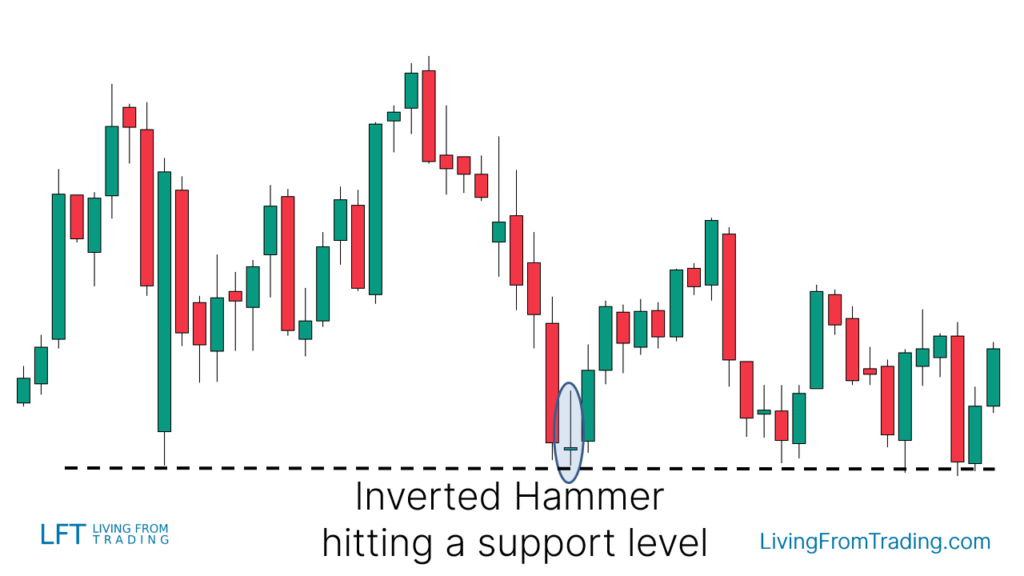
Strategy 3: Trading The Inverted Hammer With Moving Averages
Moving averages are great trading indicators to trade trends.
The idea here is to trade pullbacks to the moving average when the price is on an uptrend.
How does it work:
- Find an uptrend, with the price jumping above a moving average
- Wait for a decline in the price to the moving average
- Check if an Inverted Hammer appears at the moving average
- Go long when the price breaks the high of the Inverted Hammer
- Set your stop loss and take profit levels, and expect another leg to the upside
It looks like this:
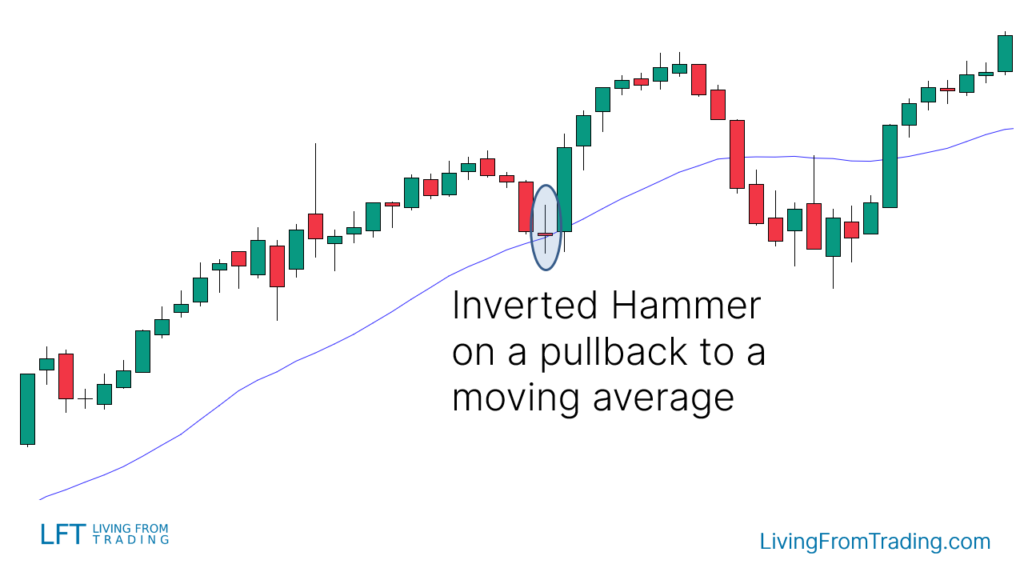
Strategy 4: Trading The Inverted Hammer With RSI Divergences
This is a bit different from the other trading strategies.
To find a bullish RSI Divergence we want to see the price on a downtrend first, making lower lows and lower highs.
Here’s how it works:
- Find a downtrend
- Mark the lows that the price makes after each leg to the downside
- At the same time compare the price lows with the RSI indicator
- When you see the RSI making higher lows while the price making lower lows, you found your divergence
- Now you wait until an Inverted Hammer appears at a price lower low, aligned with an RSI higher low.
- Go long when the price breaks the high of the Inverted Hammer
- Set your stop loss and take profit levels, and expect a move to the upside
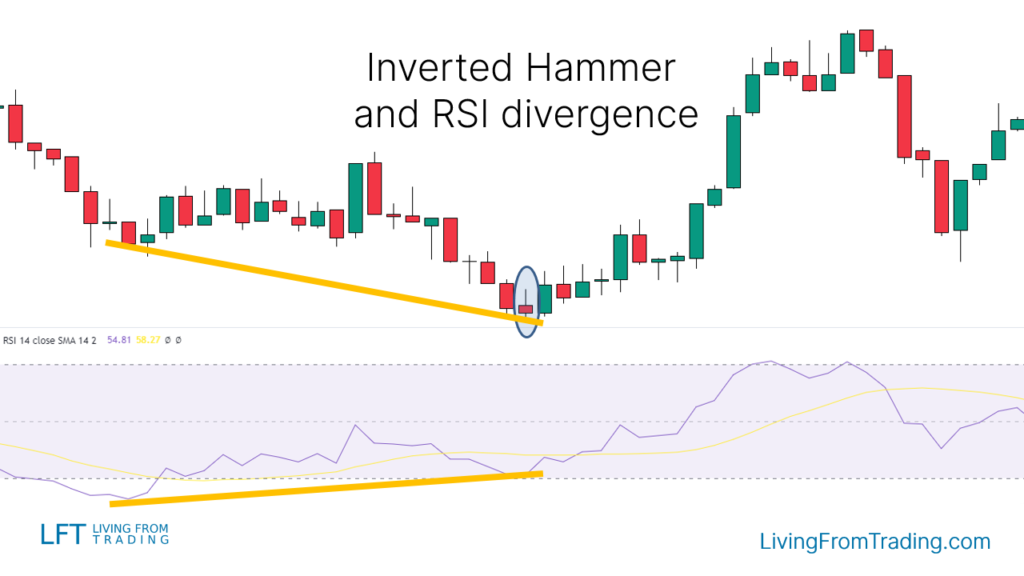
Strategy 5: Trading The Inverted Hammer With Fibonacci
Another popular way of trading the Inverted Hammer candlestick is using the Fibonacci retracement tool.
Fibonacci shows retracement levels where the price will tend to revert frequently.
Depending on the strength of the trend, different levels are more likely to work better with the Inverted Hammer pattern. Here you can learn more about the different Fibonacci retracement levels.
Here’s how the strategy works:
- You want to see the price on an uptrend
- Then you wait for a decline, they always happen at some point
- Pick your Fibonacci tool and draw the levels from the low to the high of the move
- When the price hits a Fibonacci level and prints an Inverted Hammer, that’s what you are waiting for
- Go long when the price breaks the high of the Inverted Hammer
- Set your stop loss and take profit levels, and expect a move to the upside
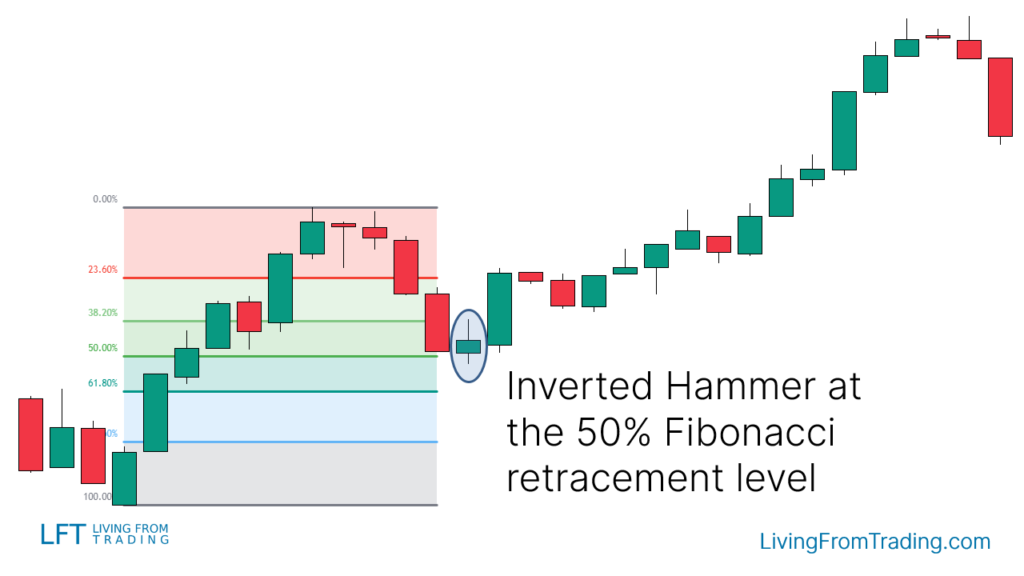
Strategy 6: Trading The Inverted Hammer With Pivot Points
Pivot Points are automatic support and resistance levels calculated using math formulas.
If you are day trading, the Daily Pivot Points are the most popular, although the Weekly and Monthly are frequently used too.
Here’s how to trade the Inverted Hammer pattern with Pivot Points:
- Activate the Pivot Points indicator on your charts
- Check which Pivot Points are under the price, those will tend to work as a support
- Ideally, you want to see the price on an uptrend, although is not required
- Wait for a decline of the price to a Pivot Point level
- At that level, you want to see an Inverted Hammer pattern appearing, meaning that the level is being rejected
- Go long when the price breaks the high of the Inverted Hammer
- Set your stop loss and take profit levels, and expect a move to the upside
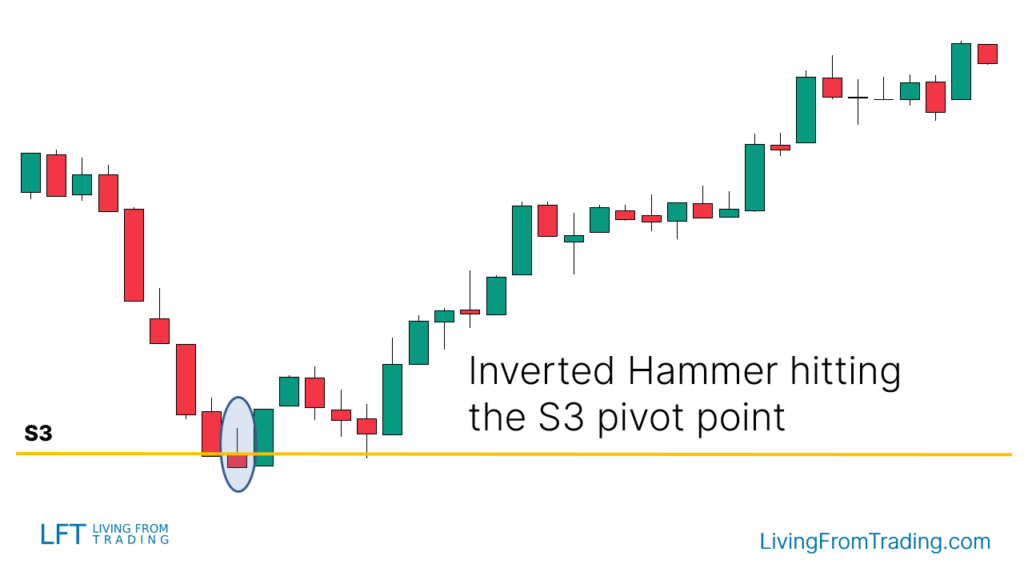
What Is The Success Rate Of The Inverted Hammer?
According to the Encyclopedia of Candlestick Charts by Thomas N. Bulkowski (link), the Inverted Hammer candlestick pattern has a success rate of 67%.
This is what you learned today
- The Inverted Hammer is a single candle pattern.
- To be valid, it must appear after a move to the downside.
- It’s a bullish reversal pattern, meaning that it signs a potential reversal to the upside.
- To increase the accuracy, you can trade the Inverted Hammer using pullbacks, moving averages, and other trading indicators.
- The winning rate of the Inverted Hammer is 67%.
Now I want to hear from you.
Do you trade the Inverted Hammer candlestick pattern?
Let me know in the comments below.
Learn More
- List of all candlestick patterns explained



You are the best teacher have come across while researching. Thank you
Thank you, Mumo.